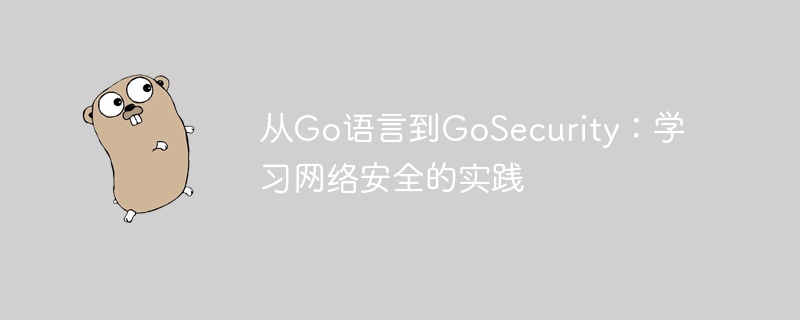Home >Backend Development >Golang >From Go Language to GoSecurity: Learning the Practice of Network Security
From Go Language to GoSecurity: Learning the Practice of Network Security
- 王林Original
- 2023-11-30 08:44:25967browse

Network security has always been a very important part of network technology, and with the development of network technology, the demand for network security is also increasing. For developers, it is very necessary to understand network security and master some basic security knowledge. This article will introduce the learning experience and practice from Go language to GoSecurity.
1. Learning Go language
Go language is a relatively new programming language, but it has been widely used in the software development industry. It has many advantages, such as efficiency, simplicity, reliability, etc., and is therefore favored by developers. For those who want to learn Go language, we recommend starting from the following three aspects:
- Basic Grammar
The first step in learning Go language is Master its basic grammar. Including data types, variables, constants, operators, control structures, functions, pointers, etc. You can learn to master it by reading technical books such as "Go Language Bible".
- Standard Library
The Go language has a rich standard library, and you can deepen your understanding of the language by learning how to use the standard library. Commonly used standard libraries include: fmt, net, time, strconv, os, etc.
- Open source project learning
The Go language was born to solve some problems within Google, so some open source projects developed by the Go language also have high reference value. You can learn the practical application of Go language by reading its source code. Such as gin, beego, echo, etc.
2. Learning Network Security
Network security is a broad and deep field that involves many aspects of knowledge. If you want to learn network security, you can start from the following aspects:
- Common attack methods
Understanding common attack methods is very helpful for learning network security. Such as: SQL injection, cross-site scripting attacks, file inclusion vulnerabilities, etc.
- Exploiting vulnerabilities
The core of network security is to find vulnerabilities and fix them, so it is also very necessary to understand how to exploit vulnerabilities. You can learn common exploit methods by reading some hacker manuals.
- Network security tools
Network security tools can help us conduct network security tests faster and better. In the process of learning network security, we should master some commonly used network security tool. Such as: nmap, metasploit, wireshark, etc.
3. Learning GoSecurity Practice
After understanding the basic knowledge of Go language and network security, we can consolidate and apply the knowledge we have learned by learning GoSecurity practice. You can learn from the following aspects:
- Writing safe code
In the actual development process, writing safe code is very necessary. In Go language, we can use some security libraries, such as: bcrypt, crypto, gRPC, etc.
- Security testing
Security testing is required after software development is completed. You can use some tools for security testing, such as: gosec, safety, golint, etc.
- Learn practical network security drills
By participating in some practical network security drills, we can help us discover and eliminate security vulnerabilities. Effectively improve our security awareness and capabilities.
Conclusion
GoSecurity is a combination of Go language and network security. Learning GoSecurity can help us better master the knowledge of Go language and network security. Through continuous learning and practice, we can better improve our skills and competitiveness.
The above is the detailed content of From Go Language to GoSecurity: Learning the Practice of Network Security. For more information, please follow other related articles on the PHP Chinese website!

